两个形容词用and或or连接作定语
- 格式:doc
- 大小:14.50 KB
- 文档页数:2
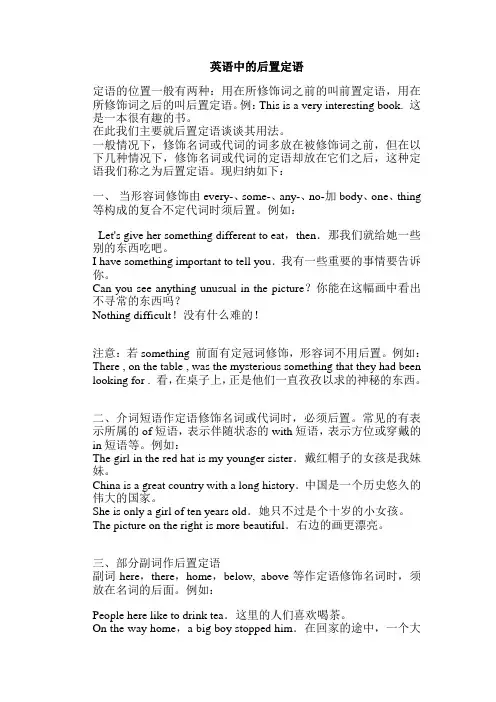
英语中的后置定语定语的位置一般有两种:用在所修饰词之前的叫前置定语,用在所修饰词之后的叫后置定语。
例:This is a very interesting book. 这是一本很有趣的书。
在此我们主要就后置定语谈谈其用法。
一般情况下,修饰名词或代词的词多放在被修饰词之前,但在以下几种情况下,修饰名词或代词的定语却放在它们之后,这种定语我们称之为后置定语。
现归纳如下:一、当形容词修饰由every-、some-、any-、no-加body、one、thing 等构成的复合不定代词时须后置。
例如:Let's give her something different to eat,then.那我们就给她一些别的东西吃吧。
I have something important to tell you.我有一些重要的事情要告诉你。
Can you see anything unusual in the picture?你能在这幅画中看出不寻常的东西吗?Nothing difficult!没有什么难的!注意:若something 前面有定冠词修饰,形容词不用后置。
例如:There , on the table , was the mysterious something that they had been looking for . 看,在桌子上,正是他们一直孜孜以求的神秘的东西。
二、介词短语作定语修饰名词或代词时,必须后置。
常见的有表示所属的of短语,表示伴随状态的with短语,表示方位或穿戴的in短语等。
例如:The girl in the red hat is my younger sister.戴红帽子的女孩是我妹妹。
China is a great country with a long history.中国是一个历史悠久的伟大的国家。
She is only a girl of ten years old.她只不过是个十岁的小女孩。
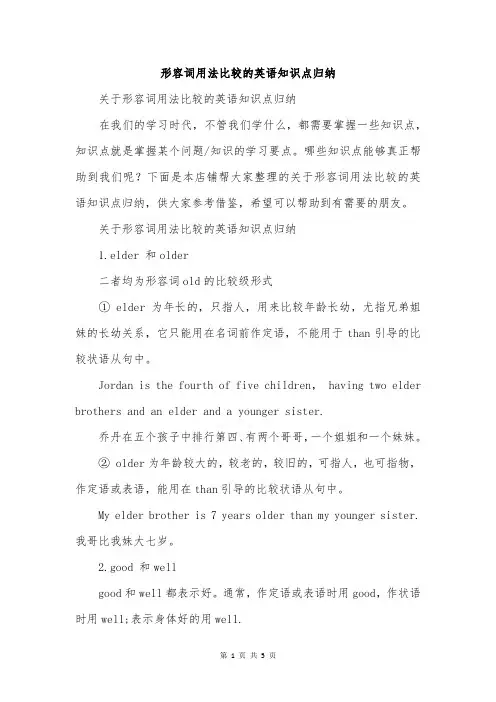
形容词用法比较的英语知识点归纳关于形容词用法比较的英语知识点归纳在我们的学习时代,不管我们学什么,都需要掌握一些知识点,知识点就是掌握某个问题/知识的学习要点。
哪些知识点能够真正帮助到我们呢?下面是本店铺帮大家整理的关于形容词用法比较的英语知识点归纳,供大家参考借鉴,希望可以帮助到有需要的朋友。
关于形容词用法比较的英语知识点归纳1.elder 和older二者均为形容词old的比较级形式① elder为年长的,只指人,用来比较年龄长幼,尤指兄弟姐妹的长幼关系,它只能用在名词前作定语,不能用于than引导的比较状语从句中。
Jordan is the fourth of five children, having two elder brothers and an elder and a younger sister.乔丹在五个孩子中排行第四、有两个哥哥,一个姐姐和一个妹妹。
② older为年龄较大的,较老的,较旧的,可指人,也可指物,作定语或表语,能用在than引导的比较状语从句中。
My elder brother is 7 years older than my younger sister.我哥比我妹大七岁。
2.good 和wellgood和well都表示好。
通常,作定语或表语时用good,作状语时用well;表示身体好的用well.Doing sports is good for us.做运动对我们有益。
(作表语) Sandy dances well and she is a good dancer.桑迪舞跳得好,她是个出色的舞者。
(well作状语,good作定语)---How are you? 你好吗?---I am very well.我很好。
(作表语,表示身体好的)3.huge, big, large,和great它们都有大的意思,但用法不同① huge强调尺寸、体积庞大(指体积时,比large, great所指的体积大),容量和数量巨大,不强调重量。
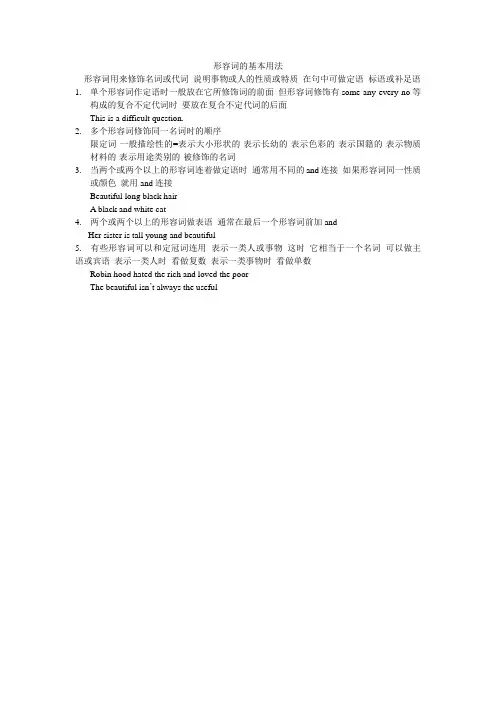
形容词的基本用法
形容词用来修饰名词或代词说明事物或人的性质或特质在句中可做定语标语或补足语1.单个形容词作定语时一般放在它所修饰词的前面但形容词修饰有some any every no等
构成的复合不定代词时要放在复合不定代词的后面
This is a difficult question.
2.多个形容词修饰同一名词时的顺序
限定词-一般描绘性的=表示大小形状的-表示长幼的-表示色彩的-表示国籍的-表示物质材料的-表示用途类别的-被修饰的名词
3.当两个或两个以上的形容词连着做定语时通常用不同的and连接如果形容词同一性质
或颜色就用and连接
Beautiful long black hair
A black and white cat
4. 两个或两个以上的形容词做表语通常在最后一个形容词前加and
Her sister is tall young and beautiful
5. 有些形容词可以和定冠词连用表示一类人或事物这时它相当于一个名词可以做主语或宾语表示一类人时看做复数表示一类事物时看做单数
Robin hood hated the rich and loved the poor
The beautiful isn’t always the useful。
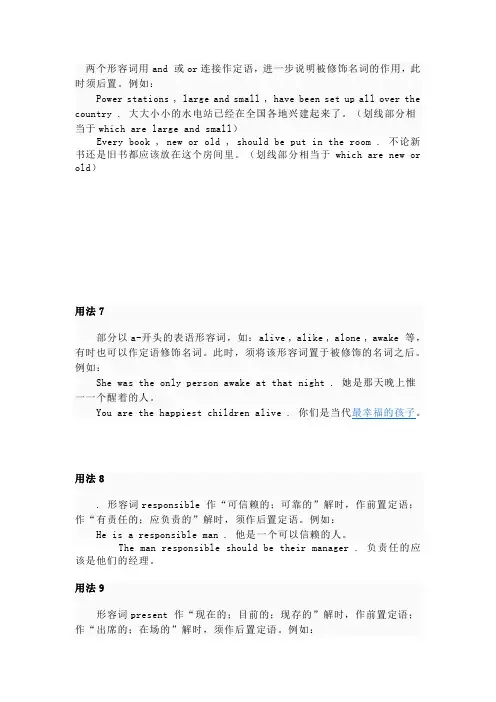
两个形容词用and 或or连接作定语,进一步说明被修饰名词的作用,此时须后置。
例如:Power stations , large and small , have been set up all over the country . 大大小小的水电站已经在全国各地兴建起来了。
(划线部分相当于which are large and small)Every book , new or old , should be put in the room . 不论新书还是旧书都应该放在这个房间里。
(划线部分相当于which are new or old)用法7部分以a-开头的表语形容词,如:alive , alike , alone , awake 等,有时也可以作定语修饰名词。
此时,须将该形容词置于被修饰的名词之后。
例如:She was the only person awake at that night . 她是那天晚上惟一一个醒着的人。
You are the happiest children alive . 你们是当代最幸福的孩子。
用法8. 形容词responsible 作“可信赖的;可靠的”解时,作前置定语;作“有责任的;应负责的”解时,须作后置定语。
例如:He is a responsible man . 他是一个可以信赖的人。
The man responsible should be their manager . 负责任的应该是他们的经理。
用法9形容词present 作“现在的;目前的;现存的”解时,作前置定语;作“出席的;在场的”解时,须作后置定语。
例如:What is your present address ? 你现在的住址是什么?The present international situation is excellent . 当前的国际形势一片大好。
The professors present at the meeting came from Shandong University . 出席这次会议的教授们来自山东大学。
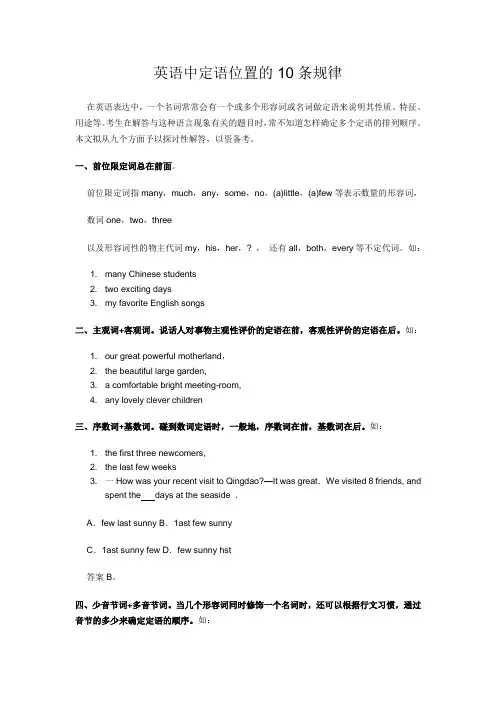
英语中定语位置的10条规律在英语表达中,一个名词常常会有一个或多个形容词或名词做定语来说明其性质、特征、用途等。
考生在解答与这种语言现象有关的题目时,常不知道怎样确定多个定语的排列顺序。
本文拟从九个方面予以探讨性解答,以资备考。
一、前位限定词总在前面。
前位限定词指many,much,any,some,no,(a)little,(a)few等表示数量的形容词,数词one,two,three以及形容词性的物主代词my,his,her,? ,还有all,both,every等不定代词。
如:1. many Chinese students2. two exciting days3. my favorite English songs二、主观词+客观词。
说话人对事物主观性评价的定语在前,客观性评价的定语在后。
如:1. our great powerful motherland,2. the beautiful large garden,3. a comfortable bright meeting-room,4. any lovely clever children三、序数词+基数词。
碰到数词定语时,一般地,序数词在前,基数词在后。
如:1. the first three newcomers,2. the last few weeks3. 一How was your recent visit to Qingdao?—It was great.We visited 8 friends, andspent the days at the seaside .A.few last sunny B.1ast few sunnyC.1ast sunny few D.few sunny hst答案B。
四、少音节词+多音节词。
当几个形容词同时修饰一个名词时,还可以根据行文习惯,通过音节的多少来确定定语的顺序。
如:1) an old exalting story2) my new Australian friend3) two tall strong-looking policemen4) a good effective method.五、(制作)方式+材料+用途。
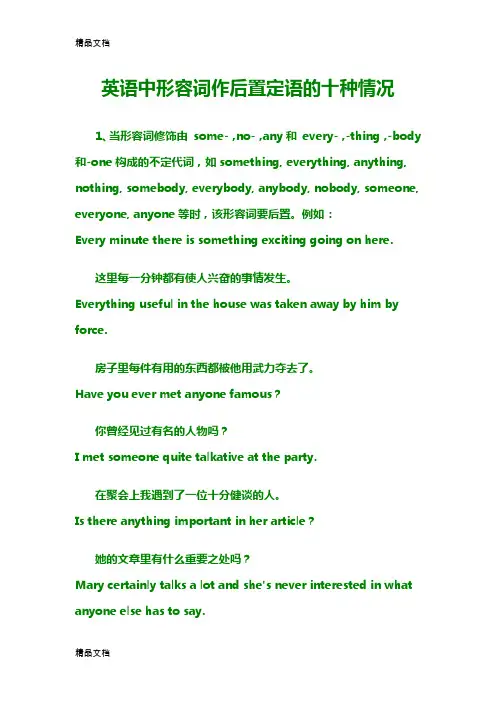
英语中形容词作后置定语的十种情况1、当形容词修饰由some-,no-,any和every-,-thing,-body 和-one构成的不定代词,如something, everything, anything, nothing, somebody, everybody, anybody, nobody, someone, everyone, anyone等时,该形容词要后置。
例如:Every minute there is something exciting going on here.这里每一分钟都有使人兴奋的事情发生。
Everything useful in the house was taken away by him by force.房子里每件有用的东西都被他用武力夺去了。
Have you ever met anyone famous?你曾经见过有名的人物吗?I met someone quite talkative at the party.在聚会上我遇到了一位十分健谈的人。
Is there anything important in her article?她的文章里有什么重要之处吗?Mary certainly talks a lot and she's never interested in what anyone else has to say.玛丽当然说的太多了,她从来对别人需要说的话不感兴趣。
The doctors have tried everything humanly possible to save his life.医生使用了可能的人道的方法去拯救他的性命。
There is nothing difficult in the world.世上无难事。
There is something wrong with my body. I am not feeling quite myself today.我的身体出问题了,今天我感觉不太好。

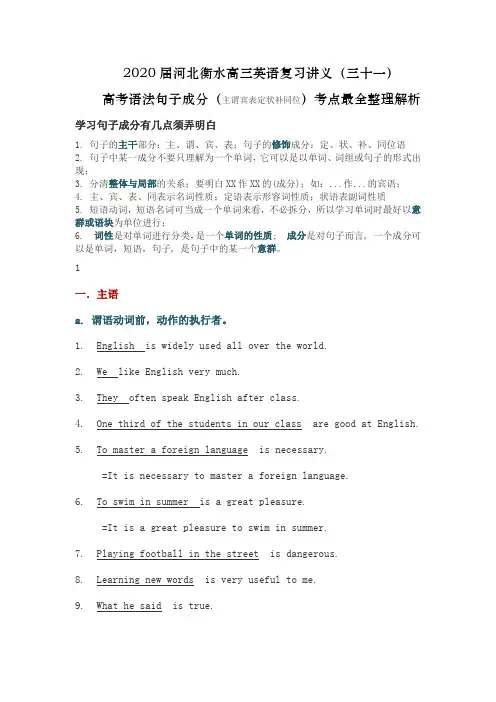
2020届河北衡水高三英语复习讲义(三十一)高考语法句子成分(主谓宾表定状补同位)考点最全整理解析学习句子成分有几点须弄明白1. 句子的主干部分:主、谓、宾、表;句子的修饰成分:定、状、补、同位语2. 句子中某一成分不要只理解为一个单词,它可以是以单词、词组或句子的形式出现;3. 分清整体与局部的关系;要明白XX作XX的(成分);如:...作...的宾语;4. 主、宾、表、同表示名词性质;定语表示形容词性质;状语表副词性质5. 短语动词,短语名词可当成一个单词来看,不必拆分,所以学习单词时最好以意群或语块为单位进行;6. 词性是对单词进行分类,是一个单词的性质; 成分是对句子而言, 一个成分可以是单词,短语,句子, 是句子中的某一个意群。
1一.主语a. 谓语动词前,动作的执行者。
1. English is widely used all over the world.2. We like English very much.3. They often speak English after class.4. One third of the students in our class are good at English.5. To master a foreign language is necessary.=It is necessary to master a foreign language.6. To swim in summer is a great pleasure.=It is a great pleasure to swim in summer.7. Playing football in the street is dangerous.8. Learning new words is very useful to me.9. What he said is true.10. Why he failed the English exam wasn’t clear.2二.谓语a. 主语所做的动作或具有的状态。
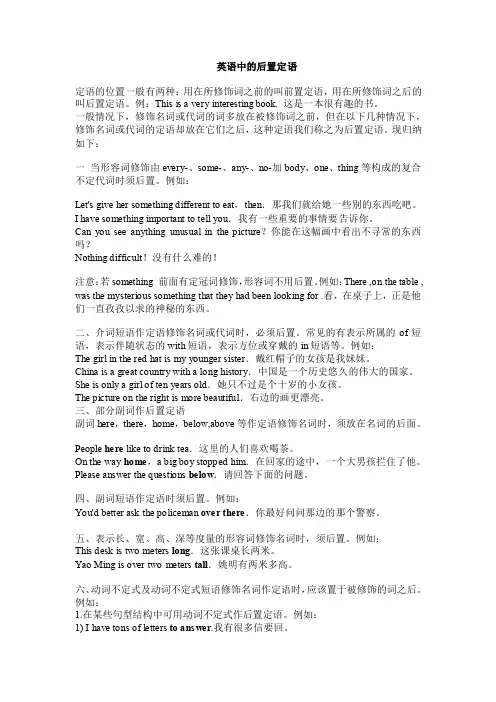
英语中的后置定语定语的位置一般有两种:用在所修饰词之前的叫前置定语,用在所修饰词之后的叫后置定语。
例:This is a very interesting book. 这是一本很有趣的书。
一般情况下,修饰名词或代词的词多放在被修饰词之前,但在以下几种情况下,修饰名词或代词的定语却放在它们之后,这种定语我们称之为后置定语。
现归纳如下:一当形容词修饰由every-、some-、any-、no-加body、one、thing等构成的复合不定代词时须后置。
例如:Let's give her something different to eat,then.那我们就给她一些别的东西吃吧。
I have something important to tell you.我有一些重要的事情要告诉你。
Can you see anything unusual in the picture?你能在这幅画中看出不寻常的东西吗?Nothing difficult!没有什么难的!注意:若something 前面有定冠词修饰,形容词不用后置。
例如:There ,on the table , was the mysterious something that they had been looking for .看,在桌子上,正是他们一直孜孜以求的神秘的东西。
二、介词短语作定语修饰名词或代词时,必须后置。
常见的有表示所属的of短语,表示伴随状态的with短语,表示方位或穿戴的in短语等。
例如:The girl in the red hat is my younger sister.戴红帽子的女孩是我妹妹。
China is a great country with a long history.中国是一个历史悠久的伟大的国家。
She is only a girl of ten years old.她只不过是个十岁的小女孩。
The picture on the right is more beautiful.右边的画更漂亮。

英语中定语位置的10条规律在英语表达中,一个名词常常会有一个或多个形容词或名词做定语来说明其性质、特征、用途等。
考生在解答与这种语言现象有关的题目时,常不知道怎样确定多个定语的排列顺序。
本文拟从九个方面予以探讨性解答,以资备考。
一、前位限定词总在前面。
前位限定词指many,much,any,some,no,(a)little,(a)few等表示数量的形容词,数词one,two,three以及形容词性的物主代词my,his,her,⋯,还有all,both,every等不定代词。
如:1.m any Chinese students2.t wo exciting days3.m y favorite English songs二、主观词+客观词。
说话人对事物主观性评价的定语在前,客观性评价的定语在后。
如:1.o ur great powerful motherland,2.t he beautiful large garden,3.a comfortable bright meeting-room,4.a ny lovely clever children三、序数词+基数词。
碰到数词定语时,一般地,序数词在前,基数词在后。
如:1.t he first three newcomers,2.t he last few weeks3.一How was your recent visit to Qingdao?—It was great.We visited 8friends, and spent the days at the seaside .A.few last sunny B.1ast few sunnyC.1ast sunny few D.few sunny hst答案B。
四、少音节词+多音节词。
当几个形容词同时修饰一个名词时,还可以根据行文习惯,通过音节的多少来确定定语的顺序。
如:1) an old exalting story2) my new Australian friend3) two tall strong-looking policemen4) a good effective method.五、(制作)方式+材料+用途。
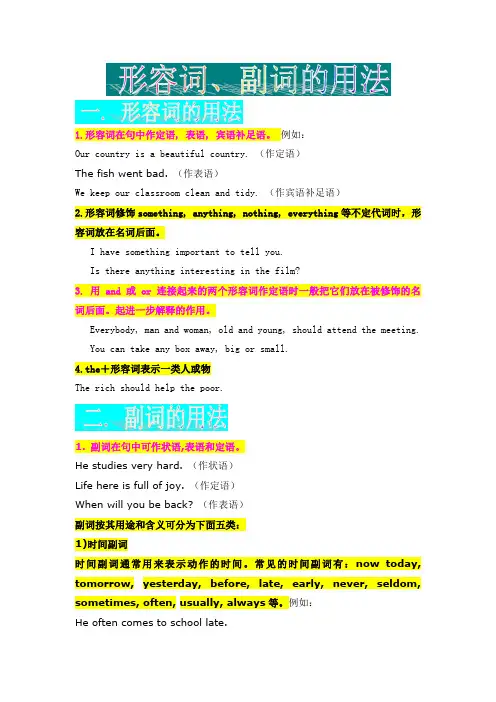
Our country is a beautiful country. (作定语)The fish went bad. (作表语)We keep our classroom clean and tidy. (作宾语补足语)2.形容词修饰something, anything, nothing, everything等不定代词时,形容词放在名词后面。
I have something important to tell you.Is there anything interesting in the film?3. 用 and 或 or 连接起来的两个形容词作定语时一般把它们放在被修饰的名词后面。
起进一步解释的作用。
Everybody, man and woman, old and young, should attend the meeting. You can take any box away, big or small.4.the+形容词表示一类人或物The rich should help the poor.1. 副词在句中可作状语,表语和定语。
He studies very hard. (作状语)Life here is full of joy. (作定语)When will you be back? (作表语)副词按其用途和含义可分为下面五类:1)时间副词时间副词通常用来表示动作的时间。
常见的时间副词有:now today, tomorrow, yesterday, before, late, early, never, seldom, sometimes, often, usually, always等。
例如:He often comes to school late.What are we going to do tomorrow?He is never been to Beijing.2)地点副词地点副词通常用来表示动作发生的地点。
高考英语语法复习
形容词与副词知识讲解
一、形容词的用法
被形容词修饰的名词若还有其他词修饰,如冠词、指示代词、形容词性物主代词等,这些词要置于形容词前。
名词前的多个修饰语可用
“限定描绘大长高,
形状年龄和新老,
颜色国籍出材料,
作用类别往后靠”
来记忆。
二、易用错的几类形容词
三、形容词的比较等级
English is as interesting a subject as Chinese.
Which is the better of the two watches?
She is the taller of the two girls.
other或else把主语排除在比较对象之外;但如果不在同一范围比较则不需要用。
Susan is taller than any girl in her sister’s class.
四、副词的句法功能
五、副词的位置
六、副词比较等级的用法。
在英语中某些定语有时放在被修饰词之后,我们称之为“后置定语”。
后置定语我们可以分为三种情况: I.单词作后置定语 1.当形容词修饰由some、any、every、no等构成的不定代词时通常放在不定代词之后。
There is nothing important in Today’s newspaper. 今天的报纸上没有重要的新闻。
2.词义具有动词性质的现在分词或过去分词作定语时一般后置。
Ihave answered all the letters received. 所有收到的信我都已经回了。
We went through a door opening on to the garden. 我们穿过通往花园的大门。
3.表示地点或时间的副词here、there、home、downstairs、upstairs、today、before等作定语时要后置。
The man downstairs came back this morning. 楼下的男子是今天上午回来的。
On the wayhome, we picked up a lot of rubbish. 在回家的路上我们拣起了很多垃圾。
4.某些形容词如last、next;enough;nearby 以及以-able、-ible结尾的形容词可用在名词之前,也可用在名词之后,其意义基本不变。
I don’t have money enough (enough money)to buy the car. 我没有足够的钱买轿车。
We went to the movie theatre last Sunday(on Sunday last). 我们上星期日去了电影院。
He hasn’t fou nd any suitable actors (actors suitable). 他还有找到合适的演员。
5.某些只能用作表语的形容词如afraid、alive、alone、asleep等作定语时一般后置。
英语中定语位置的10条规律在英语表达中,一个名词常常会有一个或多个形容词或名词做定语来说明其性质、特征、用途等。
考生在解答与这种语言现象有关的题目时,常不知道怎样确定多个定语的排列顺序。
本文拟从九个方面予以探讨性解答,以资备考。
一、前位限定词总在前面。
前位限定词指many,much,any,some,no,(a)little,(a)few等表示数量的形容词,数词one,two,three以及形容词性的物主代词my,his,her,⋯,还有all,both,every等不定代词。
如:1.m any Chinese students2.t wo exciting days3.m y favorite English songs二、主观词+客观词。
说话人对事物主观性评价的定语在前,客观性评价的定语在后。
如:1.o ur great powerful motherland,2.t he beautiful large garden,3.a comfortable bright meeting-room,4.a ny lovely clever children三、序数词+基数词。
碰到数词定语时,一般地,序数词在前,基数词在后。
如:1.t he first three newcomers,2.t he last few weeks3.一How was your recent visit to Qingdao?—It was great.We visited 8friends, and spent the days at the seaside .A.few last sunny B.1ast few sunnyC.1ast sunny few D.few sunny hst答案B。
四、少音节词+多音节词。
当几个形容词同时修饰一个名词时,还可以根据行文习惯,通过音节的多少来确定定语的顺序。
如:1) an old exalting story2) my new Australian friend3) two tall strong-looking policemen4) a good effective method.五、(制作)方式+材料+用途。
2011级中考英语备忘录单项选择题知识点渗透及讲解英语语言知识主要考察学生对具体知识点的掌握,大纲中对知识点也给出了详细的细化。
语言知识的考察重点直观体现在试卷中的单项选择和完形填空上,总结历年单项选择题,知识点的分布具体如下:词法考核:143个,占81.25%:代词:占18.18%;介词:占6.82%;动词:占34.66%;形容词:占7.95%;名词:占3.98%;冠词:占1.70%;连词:占5.11%;数词:占1.70%;副词:占1.13%;句法考核:13个,占7.38%:宾语从句:占 6.25%;定语从句:1.14%。
交际用语:13个,占7.39%。
不难看出,动词和代词的考察始终是语法知识的重点。
语言技能在听,说,读,写四个方面对学生提出具体要求,在考试中考察体现在听力理解,阅读理解,写作表达上。
看似抽象的考察,需要同学们平时的积累,多听,多读,多写。
听和阅读理解中的阅读是输入的过程,阅读理解中的理解和写作表达是输出的过程,输入和输出相辅相成,需要全面把握。
绵阳市2010年中考单项选择题第1题、冠词1.Did you notice ______ woman who was here just now? She is ______ pop star.A. the; theB. a; theC. a; aD. the; a英文字母前冠词的选择1.拼写以辅音字母开头读音却以元音开头的单词hour, honest, honor等单词的拼写虽然以辅音字母h开头,但其读音却以元音开头,因此,前面要用等单词的拼写虽然以辅音字母an。
可熟记下面这句话:An hour ago, an honest man accepted an honorable task. (一小时前,一位诚实的人接受了一项光荣的任务。
)2. 开头字母为元音字母,但发音却为辅音音素的单词前要用a, 而不是an。
如:a unit 一个单位,一个单元;a uniform 一套制服;a university 一所大学;a useful book 一本有用的书;usual, 、united, (注意这样的情况:There is a “u” in the word “sound”.)3、a European country一个欧洲人 a European girl4、one-eyed, one-way等单词的拼写虽然以元音字母开头,但其读音却以元音开头,因此,前面要用a等单词的拼写虽然以元音字母开头,但其读音却以元。
Multiple Modification(多级修饰)一、Multiple Premodification(多级修饰)1. 两个或几个同类形容词作定语,可用and 连接,词序一般是较长的形容词列于最后,如:This is a black and white cat.It was a rainy, windy and freezing day.2.当名词中心词前出现几个不同种类的形容词作修饰语时,一般按下列次序排列:限定词→性质词→大小、长度、形状、新旧→年龄→颜色→国别、来源、材料→用途或目的的形容词或分词、名词等类别词→名词中心词,如:This is a well-known Chinese medical school.It was reported that the man's first two interesting little red French oil paintings had been stolen.3. 如果出现一个以上的限定词,则按前位限定词→中位限定词→后位限定词顺序排列。
常见的限定词如下:前位限定词:all, both, twice, one-third, etc.中位限定词:a(n), the, this, that, these, those, my, your, some, any, enough, every, each, either, neither,etc.后位限定词:one, two, first, second, last, another, much, more, (a) little, (a) few, plenty of, lots of, such, etc.一个名词中心词前不可并用两个前位或中位限定词,而后位限定词则不受此限,如:For the first few evenings, he did enjoy himself greatly.All the other five boys were in the classroom.二、Multiple Postmodification(多级后位修饰)Discontinuous Modification(割裂修饰)1. Separation of Relative Clause from Its Antecedent(定语从句与所修饰的名词割裂)定语从句一般直接置于先行词之后,但有时,为了强调或为了整个句子的平衡,而与所修饰的词语隔开,如:A new teacher will come tomorrow who will teach you physics.(who 引导的定语从句和先行词teacher 被will come tomorrow 所分隔。
两个形容词用and 或or连接作定语,进一步说明被修饰名词的作用,此时须后置。
例如:
Power stations , large and small , have been set up all over the country . 大大小小的水电站已经在全国各地兴建起来了。
(划线部分相当于which are large and small)
Every book , new or old , should be put in the room . 不论新书还是旧书都应该放在这个房间里。
(划线部分相当于which are new or old)
用法7
部分以a-开头的表语形容词,如:alive , alike , alone , awake 等,有时也可以作定语修饰名词。
此时,须将该形容词置于被修饰的名词之后。
例如:
She was the only person awake at that night . 她是那天晚上惟一一个醒着的人。
You are the happiest children alive . 你们是当代最幸福的孩子。
用法8
. 形容词responsible 作“可信赖的;可靠的”解时,作前置定语;作“有责任的;应负责的”解时,须作后置定语。
例如:
He is a responsible man . 他是一个可以信赖的人。
The man responsible should be their manager . 负责任的应该是他们的经理。
用法9
形容词present 作“现在的;目前的;现存的”解时,作前置定语;作“出席的;在场的”解时,须作后置定语。
例如:
What is your present address 你现在的住址是什么
The present international situation is excellent . 当前的国际形势一片大好。
The professors present at the meeting came from Shandong University . 出席这次会议的教授们来自山东大学。
The students present welcomed the decision . 在场的学生都欢迎那个决议。